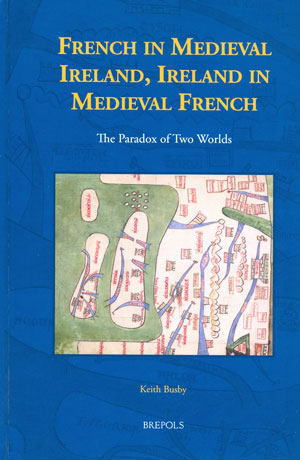FRENCH IN MEDIEVAL IRELAND, IRELAND IN MEDIEVAL FRENCH: the paradox of two worlds
Published in Book Reviews, Book Reviews, Issue 3 (May/June 2019), Reviews, Volume 27Keith Busby
Brepols
€110
ISBN 9782503570211
Reviewed by: Caoimhe Whelan
Caoimhe Whelan is a postdoctoral research fellow at the Department of History, Trinity College, Dublin.

This volume offers encyclopaedic coverage from the twelfth–fourteenth centuries of both the French language and literature in medieval Ireland and the representation of Ireland in medieval French literature. Drawing on a vast array of primary sources, frequently in manuscript, the book serves to introduce new material to many readers not necessarily familiar with literature in French and offers new suggestions regarding interpretation and context of already familiar works.
Outlining how the Anglo-Norman invasion of 1169 affected the linguistic complexities in twelfth- and thirteenth-century Ireland, Busby marshals a range of sources and evidence (some from a wider European context) to sketch the usage of French in Ireland by translators, merchants and the monastic community. He pays particular attention to Stephen of Lexington’s mission to the French-speaking monks of Mellifont Abbey and the evidence of language use provided by the writings of the Anglo-Norman propagandist of the invasion of Ireland, Gerald of Wales.
The book offers great detail on the production of and cultural context for French literature in medieval Ireland, providing a comprehensive survey of the texts that includes La Geste des Engleis en Yrlande, French material in British Library Harley MS 913 such as the ‘Walling of New Ross’, the Red Book of Ossory, the Black Book of Christ Church, Cambridge Corpus Christi College MS 405 and a range of other material, such as inscriptions. Aimed at those interested both in medieval French language and literature and in medieval Ireland, some of the material will be more familiar to some readers than to others, and Busby does a good job of providing something new for both groups.
Exploring the general idea of Ireland as a land of marvels in the Francophone world, he surveys the circulation prior to the twelfth-century invasion of texts that transmitted narratives about Ireland as a ‘wonderous isle’ and influenced the later vernacular French tradition. He draws together many fascinating examples from a range of literature, for instance the earliest list of mirabilia identified as Irish in the Historia Britonum (c. 826) and the Navigatio Sancti Brendani, a work written by an Irish monk probably from Dingle, Co. Kerry, in the last quarter of the eighth century, which later circulated in Germany and France. These works are paired with comments on, among other things, Gerald of Wales and (less well known to historians) Arthurian romance. He also focuses on ‘Irishness’ in romance literature, noting parallels between historic and literary political and diplomatic marriage, offering new insights on, for example, prose romances in medieval French and connections between Tristan, Isolte and medieval Dublin, and exploring how elements of the Arthurian story—such as Stonehenge and the Grail—seem linked to Ireland.
He offers a useful contribution to historical scholarship on La Geste des Engleis en Yrlande (otherwise known as ‘The Song of Dermot and the Earl’)—a crucial and well-known source on the twelfth-century invasion. Busby’s interrogation reveals new insights regarding the age-old question of its author (whom he suggests is a cleric); moreover, he places the work more firmly in its wider cultural context, in which it is not an isolated surviving example of French literature in Ireland.
Also important is his fresh study of the literary output of the thirteenth-century Dominican monk Jofroi of Waterford (for those interested, it is heartening to learn of Busby’s new edition of Jofroi’s work). Busby breathes new life into the question not only of the language of the text but also of where Jofroi’s literary work took place, augmenting previously known references to his collaborator Servais Copale in Liège with further references (pointing out that we may be dealing with two individuals) and, crucially, uncovering archival material that places him in Waterford as a merchant, supplier and tax-collector on wine imports. This striking new evidence allows Busby to advocate for the relocation of the writing of these literary texts from Paris to Waterford, and fits neatly with the survival of a copy of the work which fifteenth-century Dubliner James Yonge would use to form the basis for an English-language work, the Gouernaunce of Prynces, for another man with connections to Waterford (and, it should be noted, the wine trade)—James Butler, fourth earl of Ormond.
Offering a substantial study of the westernmost edge of medieval Francophonia, this book acts as a riposte to those who assumed that there was little of note in French from medieval Ireland, little attention paid to Ireland in medieval France or, indeed, little left to say on the subject. The relative neglect of this period means that Busby has had to do much spadework and his dedication has uncovered a vast array of material. The voluminous nature of the book is somewhat daunting for all but the most dedicated of readers, but for those of us interested in medieval Ireland and medieval literature Busby’s references and translations of a range of sources are of tremendous practical value.
















